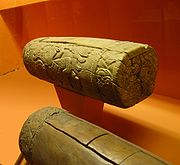
Teponaztli
Encyclopedia


Slit drum
A slit drum is a hollow percussion instrument, usually a log drum of bamboo or wood, that is made with one or more slits in it. Most slit drums have three slits, cut into the shape of an "H". If, as is usual, the resultant tongues are different lengths or thicknesses, the drum will produce two...
used in central Mexico by the Aztec
Aztec
The Aztec people were certain ethnic groups of central Mexico, particularly those groups who spoke the Nahuatl language and who dominated large parts of Mesoamerica in the 14th, 15th and 16th centuries, a period referred to as the late post-classic period in Mesoamerican chronology.Aztec is the...
s and related cultures.
Structure
Teponaztli are made of hollow hardwood logs, often fire-hardened. Like most slit drums, teponaztli have three slits on their topside, cut into the shape of an "H". The resultant tongues are then struck with rubber balls on mallets, which were often made of deer antlers. Since the tongues are of different lengths, or carved into different thicknesses, the teponaztli produces 2 different pitches, usually a thirdMajor third
In classical music from Western culture, a third is a musical interval encompassing three staff positions , and the major third is one of two commonly occurring thirds. It is qualified as major because it is the largest of the two: the major third spans four semitones, the minor third three...
or fourth
Perfect fourth
In classical music from Western culture, a fourth is a musical interval encompassing four staff positions , and the perfect fourth is a fourth spanning five semitones. For example, the ascending interval from C to the next F is a perfect fourth, as the note F lies five semitones above C, and there...
apart.
Teponaztli were usually decorated with relief carvings of various deities or with abstract designs, and were even carved into the shapes of creatures or humans. Some of these creatures are open-mouthed, providing increased volume through the hole at the end. On other drums, a hole was made on the drum's underside. Teponaztli from the Mixtec
Mixtec
The Mixtec are indigenous Mesoamerican peoples inhabiting the Mexican states of Oaxaca, Guerrero and Puebla in a region known as La Mixteca. The Mixtecan languages form an important branch of the Otomanguean language family....
culture in what is today south-central Mexico are known for their various battle or mythological scenes carved in relief.
These drums ranged in size from about 1 foot (30 cm) to 4 feet (1.2 metres) long. The larger teponaztli would be rested upon a supporting frame. The smaller ones could either be rested on a frame or carried by straps about the shoulders.
Use
The drums were used in dances, poetry, celebrations (as shown in the Florentine CodexFlorentine Codex
The Florentine Codex is the common name given to a 16th century ethnographic research project in Mesoamerica by Franciscan friar Bernardino de Sahagún. Bernardino originally titled it: La Historia General de las Cosas de Nueva Espana...
above) or in warfare as a means of communication. According to some sources, on important state occasions the blood of sacrificial victims was at times poured into the drum.
Motolinia, a Franciscan friar and chronicler of post-conquest Aztec life, stated that the teponaztli, or as he called it the contrabajos (counterbass), was often played with the huehuetl
Huehuetl
The huehuetl is a percussion instrument from Mexico, used by the Aztecs and other cultures. It is an upright tubular drum made from a wooden body opened at the bottom that stands on three legs cut from its base, with skin stretched over the top. It can be beaten by hand or wood mallet...
skin drum to accompany various dances. In addition to dances, teponaztlis were used to accompanied poetry readings: the sounds of the drum even at times appear within the poetry itself ("totocoto tototo cototo tiquititi titiqui tiquito"). This solfege
Solfege
In music, solfège is a pedagogical solmization technique for the teaching of sight-singing in which each note of the score is sung to a special syllable, called a solfège syllable...
-style notation allows us to reconstruct the rhythms and sounds of the Aztecs.
Strokes
Each drum pattern is written using four syllables: To, Ko, Ti, KiPitch:
- To and Ko: low tones
- Ti and Ki: high tones
Beat:
- To and Ti: downbeats
- Ko and Ki: upbeats

